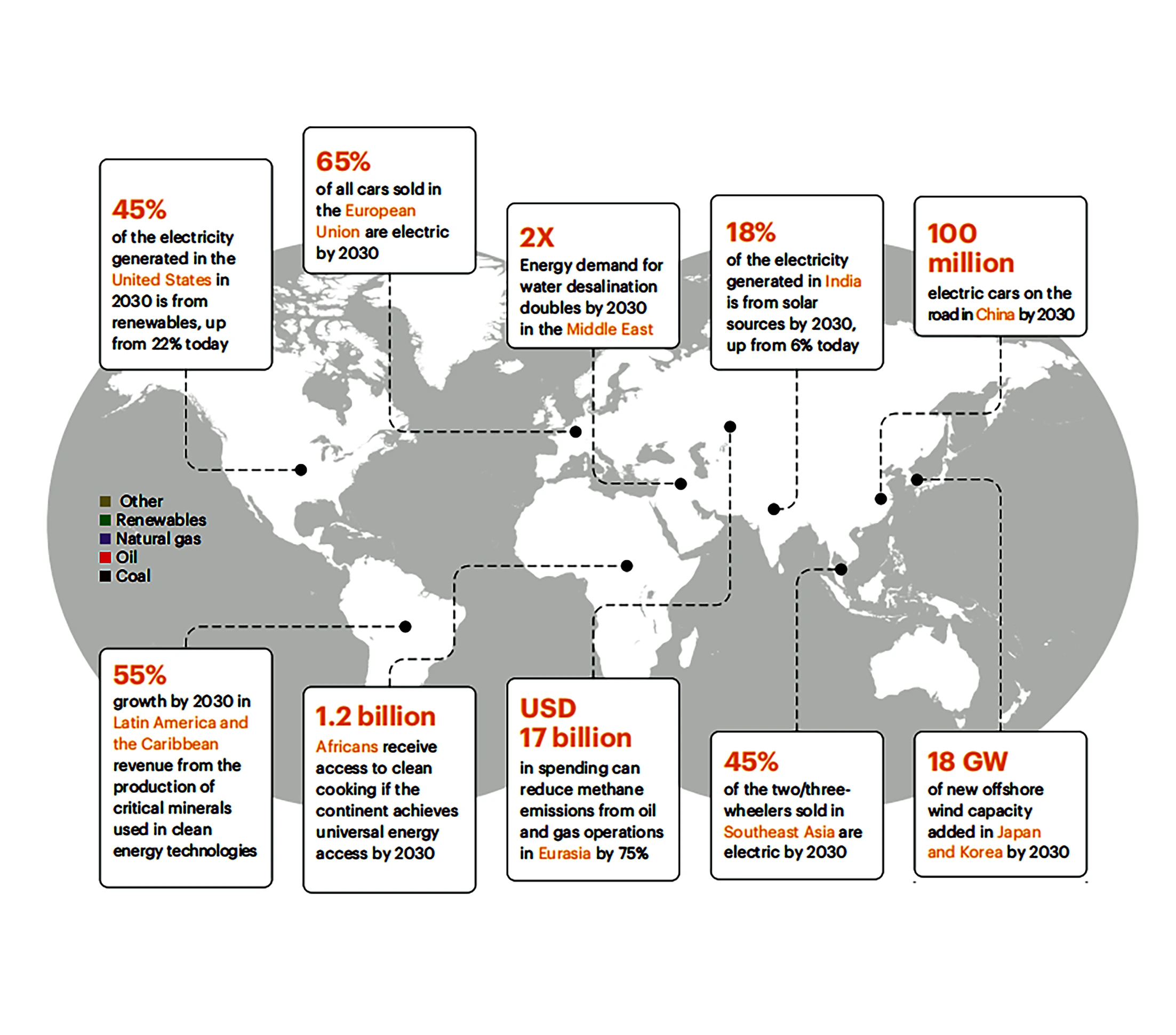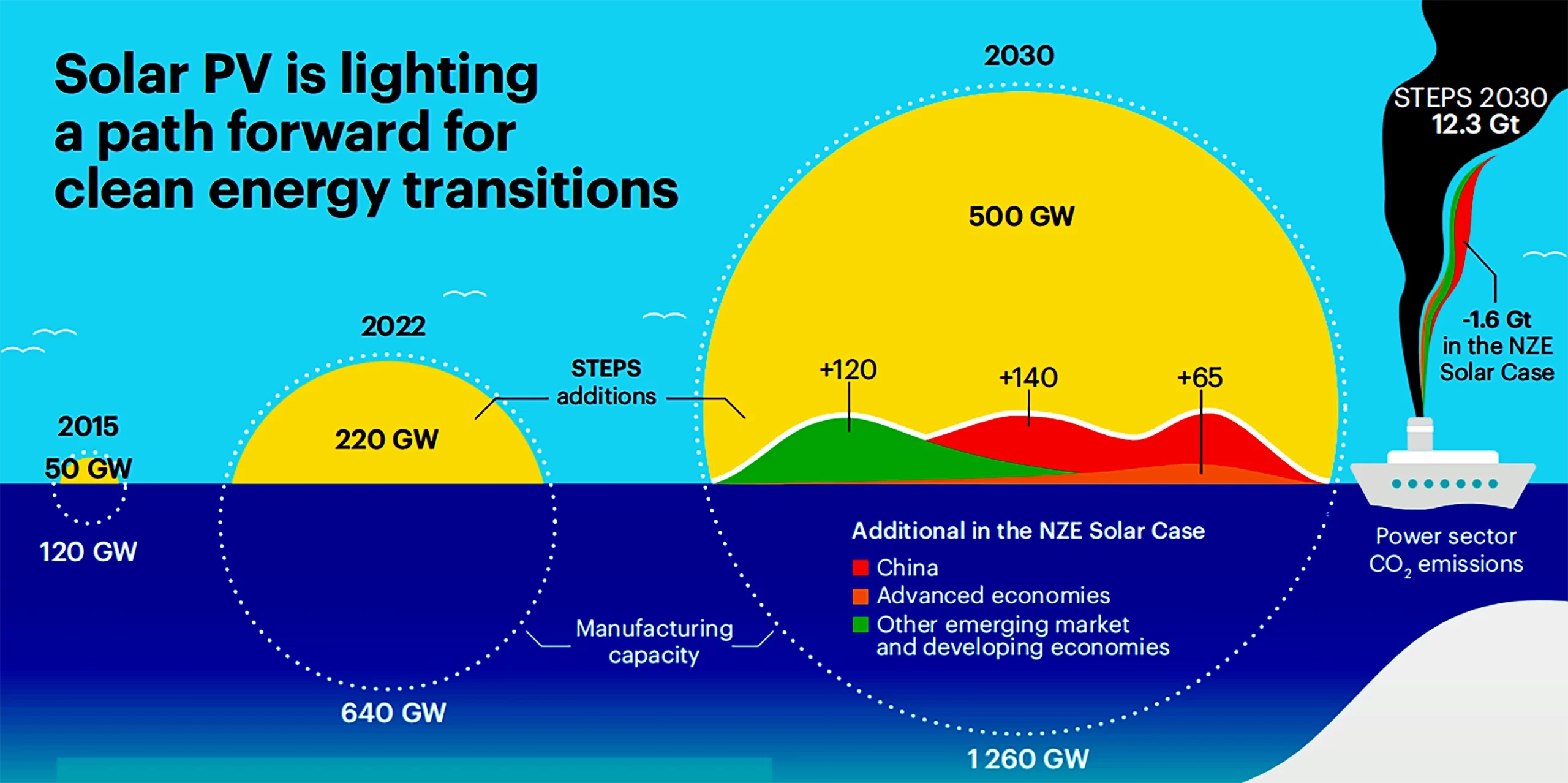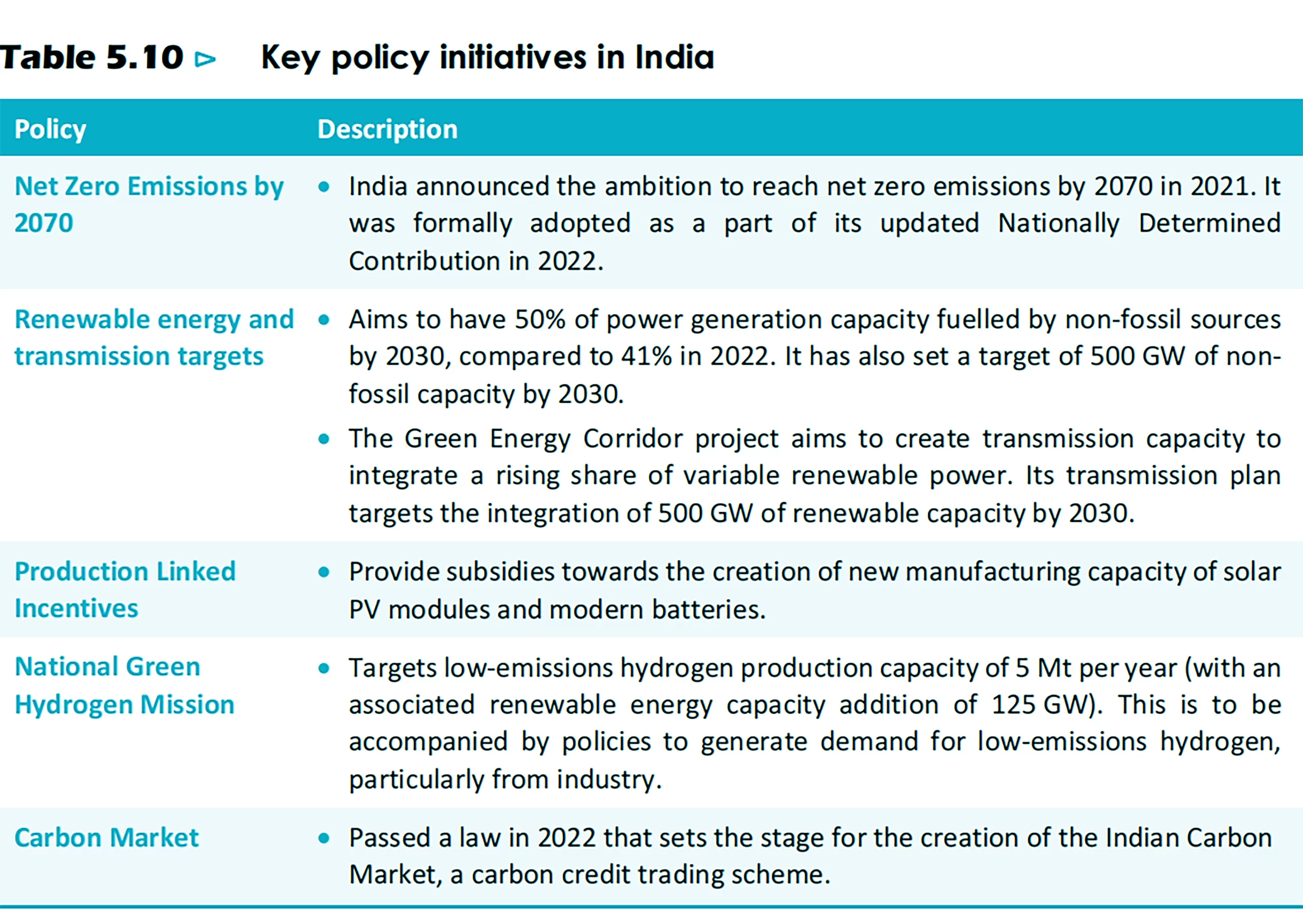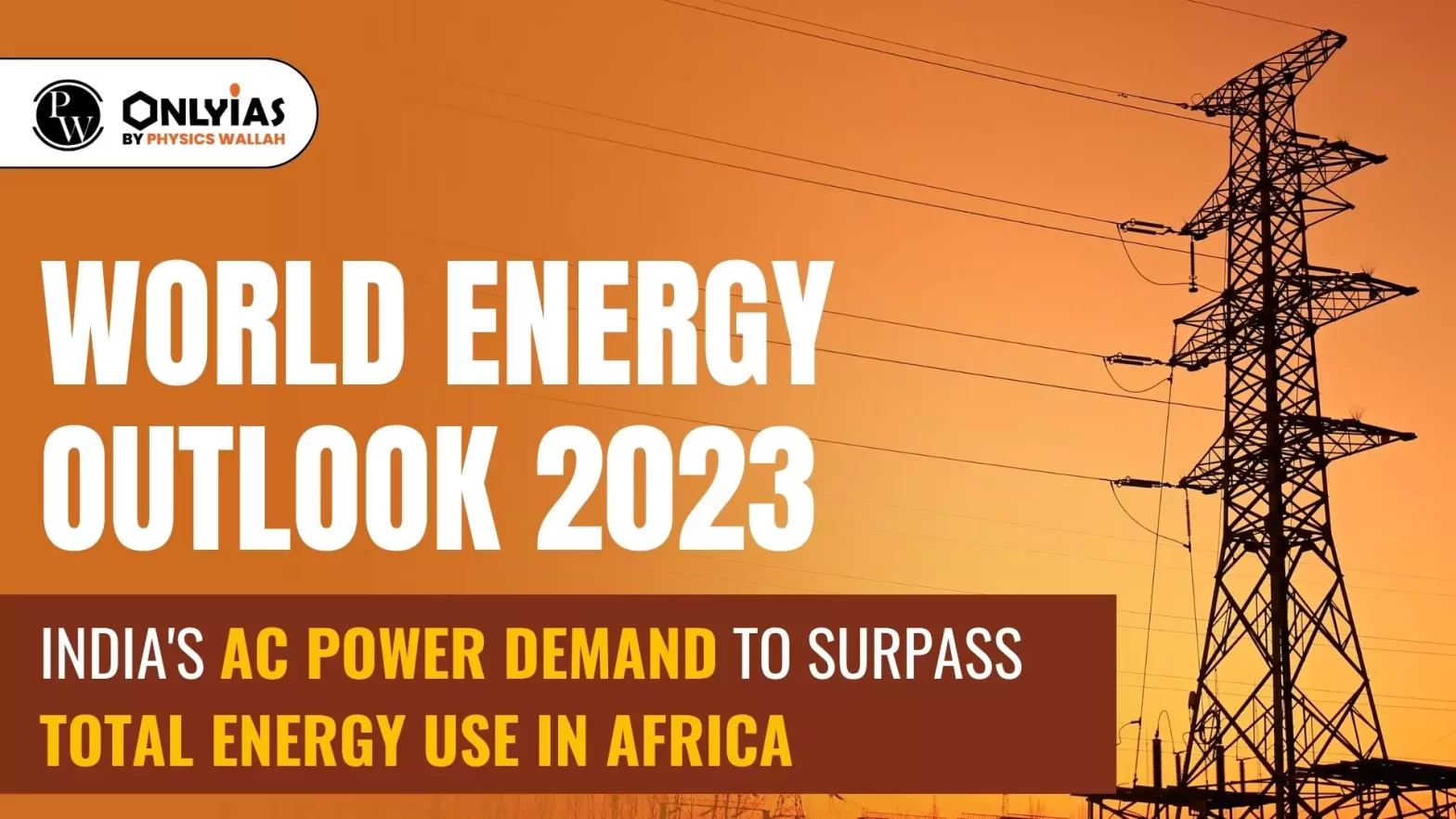Context:
| Relevancy for Prelims: World Energy Outlook 2023, India’s Electricity Demand, International Energy Agency, Net Zero Emissions, and UJALA scheme.
Relevancy for Mains: World Energy Outlook 2023: Key Findings; India’s Clean Energy Status, New Clean Energy Economy: Opportunities for India and the World, and current critical challenges of the energy sector for India & World. |
World Energy Outlook 2023: Key Findings
- Global Geopolitics: Energy markets, geopolitics, and the global economy are unsettled and the risk of further disruption is present.
- The risk of protracted conflict in the Middle East now accompanies continued fighting in Ukraine.
- Global Average Surface Temperature: It is already around 1.2 °C above pre-industrial levels, prompting heatwaves and other extreme weather events, and greenhouse gas emissions have not yet peaked.
- The Energy Sector: It is also the primary cause of the polluted air linked to more than 6 million premature deaths yearly.
- Positive trends in improving access to electricity and clean cooking have slowed or even reversed in some countries.

What is the World Energy Outlook?
- The IEA releases the WEO annually which provides in-depth analysis and strategic insights into every aspect of the global energy system.
- The analysis explores different scenarios that reflect current real-world conditions and starting points:
- Stated Policies Scenario (STEPS): It depicts the current direction for the energy economy.
- Announced Pledges Scenario (APS): It depicts future directions (if all countries were to hit their aspirational targets on time and in full).
- Updated Net Zero Emissions by 2050 (NZE) Scenario: Illustrates what is required to limit global warming to 1.5 degrees Celsius (°C).
What is IEA?
- The IEA was established in 1974 within the framework of the OECD.
- Primary Mission: Promote energy security among its member countries, which are mostly industrialized and oil-importing nations.
- The IEA was established in response to the the 1973 oil crisis, highlighting the need for coordinated international efforts to address energy-related issues.
- India: Although India is not a member, it is one of the association countries.
|
India’s Clean Energy Status
- India’s Energy Landscape: It is marked by a long-term net zero emissions ambition, increased regulatory sophistication, a focus on clean energy deployment, and the creation of domestic clean energy technology supply chains.
- Energy Access: Since 2000, India has brought electricity to 810 million people, larger than the population of the European Union and the United States combined. India has also brought clean cooking access to 655 million people over the same period.
- Energy Efficiency: India has had the single largest light-emitting diode (LED) adoption campaign globally, with around 370 million LEDs distributed through the UJALA scheme by 2023.
- Investment: While clean energy investment in India will more than double in the STEPS by 2030 from around USD 60 billion in 2022, investment needs to nearly triple by the end of this decade to be on a trajectory to meet its net zero emissions target.

Also read: Growth Needs More Electricity: Strengthening of Power Sector
New Clean Energy Economy: Opportunities for India and the World
- Emergence of a New Clean Energy Economy: Led by solar PV and electric vehicles (EVs). Investment in clean energy has risen by 40% since 2020.
- Energy Security: This is important, particularly for fuel-importing countries, as are industrial strategies and the desire to create clean energy jobs. For instance, India’s oil import dependency was 84.4% in 2020-21.
- Thriving Clean Technologies: In 2020, one in 25 cars sold was electric; in 2023, this is now one in 5 leading to more than 500 gigawatts (GW) of renewable generation capacity to be added in 2023.
- Clean Energy Growth: India is recognized as a clean energy powerhouse, accounting for a significant portion of wind and solar additions and EV sales. This indicates that India has the potential to lead in clean energy adoption and manufacturing.
- For instance, solar and wind drove 92% of india’s electricity capacity additions in 2022
- Other Measures:
- Renewable Energy: Renewables are expected to contribute to global new power capacity which allows India to reduce fossil fuel dependence.
- Improvements in Efficiency: India can make significant strides in improving energy efficiency, which can contribute to meeting energy and climate targets.

What are the current critical challenges of the energy sector for India & World?
- Changing Demography: There are aging populations in the European Union, Russia, Japan, and China whereas there is an increasing population in India and Africa.
- India’s urban population will increase by 74% and per capita income will triple by 2050, increasing demand for oil and natural gas and leading to a rise in India’s annual CO2 emissions by nearly 30% by 2050, one of the world’s largest increases.
- High Technology Costs: Higher input prices for critical minerals, semiconductors and bulk materials such as steel and cement have negatively affected the financial performance of some major clean technology suppliers and project developers in the short term.
- For example, Hydrogen and carbon capture, utilization and storage (CCUS) projects show that more than 400 GW of electrolysis for hydrogen and over 400 million tonnes of CO2 capture capacity are vying to be operational by 2030.
- Increasing Investment in Fossil Fuel Dependence: The share of coal, oil and natural gas in global energy supply starts to go downwards and reaches 73% in the STEPS by 2030 whereas investment in oil and gas today is almost double the level required in the NZE Scenario in 2030.
- Energy Poverty: The importance of ensuring cost-effective and clean technologies are deployed, especially in poorer households and communities and affordability is a concern in India’s transition to cleaner energy sources.
- Impact of Air Conditioners (ACs) on Electricity Demand: India’s demand for electricity for running household ACs is estimated to expand nine-fold by 2050 and will exceed total power consumption in Africa today.
- Although solar PV matches well with daytime cooling needs, cooling demand is also significant in India during the late evening and at night.
- Import Dependence: India is an importer of modern clean energy technologies as it scales up solar and wind power generation capacity.
- For example, its imports of solar PV modules in 2021-2022 were valued at USD 3.4 billion.
Way Forward
- Meeting National Energy and Climate Targets: Clean electrification, improvements in energy efficiency and switching to lower- and zero-carbon fuels are key levers available to emerging and developing economies to reach their national energy and climate targets.
- In India, it means every dollar of value added by India’s industry results in 30% less carbon dioxide (CO2) by 2030, and each kilometer driven by a passenger car, on average, emits 25% less CO2.
- Diversification and Innovation: These are the best strategies to manage supply chain dependencies for clean energy technologies and critical minerals and to strengthen the resilience of clean energy supply chains and reduce high levels of concentration.
- Ensuring Affordability: India, Africa and other low-income countries need to work on policies to ensure the affordability of clean energy technologies, especially for low-income households.
- Meeting Energy Demand of Increasing Population: Finding and financing low-emissions ways to meet rising energy demand in these economies is a vital determinant of the speed at which global fossil fuel use eventually falls.
- Reducing Peak Electricity Demand: By implementing building codes, using more efficient appliances and adopting demand response measures that enable the same cooling needs to be met with less energy.
- Lowering Cooling Demand: Energy efficiency policies reduce the need for investment in batteries or expensive standby generation capacity, and thus help to integrate renewables more cost-effectively.
Conclusion:
India can lead in the transition to clean energy, given its growth in renewable energy, clean electrification, and efforts to improve energy efficiency to achieve a sustainable and inclusive energy future.
| Prelims Question (2023)
Consider the following infrastructure sectors:
1. Affordable housing
2. Mass rapid transport
3. Health care
4. Renewable energy
On how many of the above does UNOPS Sustainable Investments in Infrastructure and Innovation (S3i) initiative focus for its investments?
(a) Only one
(b) Only two
(c) Only three
(d) All four
Ans: (c) |
![]() 26 Oct 2023
26 Oct 2023




